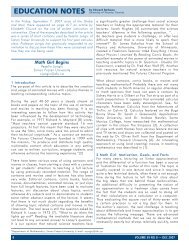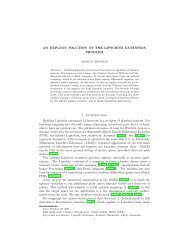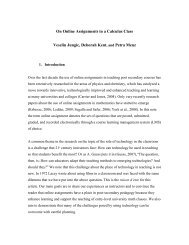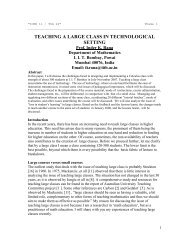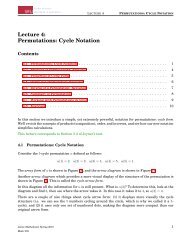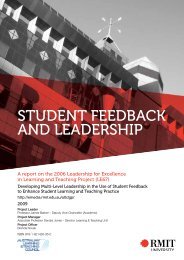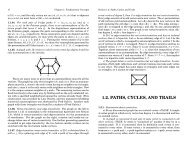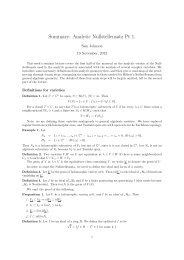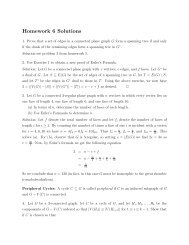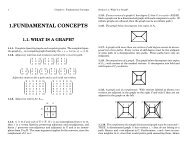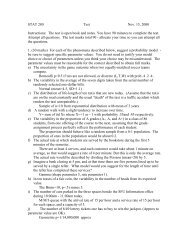Lecture 15: Mastering the Oval Track Puzzle - People.stat.sfu.ca
Lecture 15: Mastering the Oval Track Puzzle - People.stat.sfu.ca
Lecture 15: Mastering the Oval Track Puzzle - People.stat.sfu.ca
You also want an ePaper? Increase the reach of your titles
YUMPU automatically turns print PDFs into web optimized ePapers that Google loves.
Week Date Sections<br />
from FS2009<br />
Part/ References Topic/Sections Notes/Speaker<br />
1 Sept 7 I.1, I.2, I.3 Combinatorial Symbolic methods<br />
2 14 I.4, I.5, I.6<br />
Structures<br />
FS: Part A.1, A.2<br />
Unlabelled structures<br />
3 21 II.1, II.2, II.3<br />
Comtet74<br />
Handout #1<br />
Labelled structures I<br />
4 28 II.4, II.5, II.6<br />
(self study)<br />
Labelled structures II<br />
5 Oct 5 III.1, III.2<br />
Combinatorial<br />
parameters<br />
FS A.III<br />
(self-study)<br />
Combinatorial<br />
Parameters<br />
6 12 IV.1, IV.2 Multivariable GFs<br />
Asst #1 Due<br />
7 19 IV.3, IV.4 Analytic Methods Complex Analysis<br />
8<br />
9<br />
26<br />
Nov 2<br />
IV.5 V.1<br />
FS: Part B: IV, V, VI<br />
Appendix B4<br />
Stanley 99: Ch. 6<br />
Handout #1<br />
Singularity Analysis<br />
Asymptotic methods<br />
Asst #2 Due<br />
10<br />
9 VI.1<br />
(self-study)<br />
Sophie<br />
12 A.3/ C<br />
Introduction to Prob. Mariolys<br />
11<br />
12<br />
f aculty of science MATH 895-4 Fall 2010<br />
department of ma<strong>the</strong>matics Course Schedule<br />
LECTURE <strong>15</strong> MASTERING THE OVAL TRACK PUZZLE<br />
<strong>Lecture</strong> <strong>15</strong>:<br />
<strong>Mastering</strong> <strong>the</strong> <strong>Oval</strong> <strong>Track</strong> <strong>Puzzle</strong><br />
Contents<br />
<strong>15</strong>.1 <strong>Oval</strong> <strong>Track</strong> with T = (1, 4)(2, 3) . . . . . . . . . . . . . . . . . . . . . . . . . . . . . . . . . . . . . . . 1<br />
<strong>15</strong>.1.1 2-cycles . . . . . . . . . . . . . . . . . . . . . . . . . . . . . . . . . . . . . . . . . . . . . . . . . 2<br />
<strong>15</strong>.1.2 3-cycles . . . . . . . . . . . . . . . . . . . . . . . . . . . . . . . . . . . . . . . . . . . . . . . . . 4<br />
<strong>15</strong>.1.3 Strategy for Solution . . . . . . . . . . . . . . . . . . . . . . . . . . . . . . . . . . . . . . . . . 5<br />
<strong>15</strong>.1.4 Changing <strong>the</strong> number of disks . . . . . . . . . . . . . . . . . . . . . . . . . . . . . . . . . . . . 8<br />
18 IX.1 Limit Laws and Comb Marni<br />
20 IX.2 Random Structures<br />
and Limit Laws<br />
Discrete Limit Laws Sophie<br />
23 IX.3<br />
FS: Part C<br />
(rotating<br />
presentations)<br />
Combinatorial<br />
instances of discrete<br />
Mariolys<br />
25 IX.4 Continuous Limit Laws Marni<br />
<strong>15</strong>.2 Variations of <strong>the</strong> <strong>Oval</strong> <strong>Track</strong> T move . . . . . . . . . . . . . . . . . . . . . . . . . . . . . . . . . . . . 12<br />
<strong>15</strong>.3 Exercises . . . . . . . . . . . . . . . . . . . . . . . . . . . . . . . . . . . . . . . . . . . . . . . . . . . . 13<br />
Quasi-Powers and<br />
We 13now 30 have IX.5enough<br />
<strong>the</strong>ory developed Sophie<br />
Gaussian to give limit alaws thorough analysis of <strong>the</strong> <strong>Oval</strong> <strong>Track</strong> puzzle.<br />
The 14 interested Dec 10 reader may wish Presentations to see <strong>the</strong> book <strong>Oval</strong> <strong>Track</strong> Asst #3 Due and o<strong>the</strong>r Permutation <strong>Puzzle</strong>s by J.O. Kiltinen for<br />
fur<strong>the</strong>r reading. A link in <strong>the</strong> software section of our website will take you to his page where you <strong>ca</strong>n download<br />
a demo version of <strong>the</strong> <strong>Oval</strong> <strong>Track</strong> puzzle.<br />
<strong>15</strong>.1 <strong>Oval</strong> <strong>Track</strong> with T = (1, 4)(2, 3)<br />
In this section we focus on <strong>the</strong> standard <strong>Oval</strong> <strong>Track</strong> puzzle as shown in Figure 1. This version is also known<br />
as TopSpin and was once manufactured by Binary Arts (now ThinkFun).<br />
Dr. Marni MISHNA, Department of Ma<strong>the</strong>matics, SIMON FRASER UNIVERSITY<br />
Version of: 11-Dec-09<br />
Figure 1: <strong>Oval</strong> <strong>Track</strong> puzzle.<br />
The two basic moves of <strong>the</strong> <strong>Oval</strong> <strong>Track</strong> puzzle are R, and T , where R denotes a clockwise rotation of numbers<br />
around <strong>the</strong> track, where each number moves one space, and T denotes a rotation of <strong>the</strong> turntable.<br />
The permutation corresponding to <strong>the</strong> legal moves R and T are as follows:<br />
Jamie Mulholland, Spring 2011<br />
Math 302<br />
R = (1, 2, 3, 4, 5, 6, 7, 8, 9, 10, 11, 12, 13, 14, <strong>15</strong>, 16, 17, 18, 19, 20)<br />
T = (1, 4)(2, 3)<br />
<strong>15</strong>-1
Week Date Sections<br />
from FS2009<br />
Part/ References Topic/Sections Notes/Speaker<br />
Note 1 that Sept 7 T I.1, I.2, I.3 Combinatorial Symbolic methods<br />
2 14 I.4, I.5, I.6<br />
Structures<br />
FS: Part A.1, A.2<br />
Unlabelled structures<br />
Comtet74<br />
3 21 II.1, II.2, II.3 Labelled structures I<br />
Handout #1<br />
4 28 II.4, II.5, II.6<br />
(self study)<br />
Labelled structures II<br />
−1 = T since T has order 2, and R−1 represents a counterclockwise rotation of <strong>the</strong> disks along <strong>the</strong><br />
track.<br />
Let’s get right down to business and find out which permutations of <strong>the</strong> 20 disks are possible. We <strong>ca</strong>n set-up<br />
5 Oct 5 III.1, III.2<br />
Combinatorial<br />
parameters<br />
FS A.III<br />
(self-study)<br />
Combinatorial<br />
Parameters<br />
Asst #1 Due<br />
7 19 IV.3, IV.4 Analytic Methods Complex Analysis<br />
8<br />
9<br />
26<br />
Nov 2<br />
IV.5 V.1<br />
FS: Part B: IV, V, VI<br />
Appendix B4<br />
Stanley 99: Ch. 6<br />
Handout #1<br />
Singularity Analysis<br />
Asymptotic methods<br />
Asst #2 Due<br />
10<br />
9 VI.1<br />
(self-study)<br />
Sophie<br />
12 A.3/ C<br />
Introduction to Prob. Mariolys<br />
Therefore, 18 all IX.1possible permutations of Limit <strong>the</strong> Laws puzzle and Combpieces Marni are possible. We could have instead asked SAGE if<br />
11<br />
OT is 20 <strong>the</strong> symmetric IX.2 group Random S20 Structures to achieve Discrete <strong>the</strong> Limit same Laws result. Sophie<br />
and Limit Laws<br />
FS: Part C<br />
23 IX.3<br />
(rotating<br />
sage: 12 OT==SymmetricGroup(20)<br />
presentations)<br />
Combinatorial<br />
instances of discrete<br />
SAGE Mariolys<br />
25 IX.4 Continuous Limit Laws Marni<br />
13 30 IX.5<br />
f aculty of science MATH 895-4 Fall 2010<br />
department of ma<strong>the</strong>matics Course Schedule<br />
LECTURE <strong>15</strong> MASTERING THE OVAL TRACK PUZZLE<br />
and <strong>the</strong> <strong>Oval</strong> <strong>Track</strong> puzzle group is OT = 〈R, T 〉.<br />
<strong>the</strong> corresponding puzzle group OT in SAGE and compute its order. Since <strong>the</strong> maximum possible number of<br />
permutation is 20! we’ll ask if <strong>the</strong> order of OT is this value.<br />
SAGE<br />
6 12 IV.1, IV.2 Multivariable GFs<br />
sage: S20=SymmetricGroup(20)<br />
sage: R=S20("(1,2,3,4,5,6,7,8,9,10,11,12,13,14,<strong>15</strong>,16,17,18,19,20)")<br />
sage: T=S20("(1,4)(2,3)")<br />
sage: OT=S20.subgroup([R,T])<br />
sage: OT.order()==factorial(20)<br />
True<br />
True<br />
Quasi-Powers and<br />
Gaussian limit laws<br />
Sophie<br />
Theorem 14 Dec 10 <strong>15</strong>.1 (SolvabilityPresentations Criteria for <strong>Oval</strong> <strong>Track</strong> Asst puzzle) #3 Due For <strong>the</strong> <strong>Oval</strong> <strong>Track</strong> puzzle with 20 disks and<br />
T = (1, 4)(2, 3), every permutation α ∈ S20 is solvable. In o<strong>the</strong>r words, OT = S20.<br />
Knowing that all permutation in S20 are obtainable is a start, but we actually would like to know how to solve<br />
<strong>the</strong> puzzle from any arrangement of <strong>the</strong> disks. Moreover, it would be nice to see exactly why SAGE is correct<br />
in <strong>stat</strong>ing OT = S20; <strong>the</strong> algorithms implemented in SAGE to do <strong>the</strong>se <strong>ca</strong>lculations are beyond <strong>the</strong> scope of<br />
this course.<br />
The <strong>the</strong>ory we have developed provides us with <strong>the</strong> answer as to why OT = S20. In <strong>Lecture</strong> 13 we found a<br />
square commutator that produces a 3-cycle:<br />
Dr. Marni MISHNA, Department of Ma<strong>the</strong>matics, SIMON FRASER UNIVERSITY<br />
Version of: 11-Dec-09<br />
[R −3 , T ] 2 = (1, 7, 4).<br />
The puzzle provides us enough flexibility, or “wiggle room”, to bring any 3 disks into positions 1, 7, 4. See<br />
Exercise 3 for some practice in doing this. Therefore we may perform any 3-cycle by conjugation. See Section<br />
<strong>15</strong>.1.2 for an example. This means we <strong>ca</strong>n produce any even permutation of <strong>the</strong> 20 disks, so A20 < OT . Also,<br />
OT contains an odd permutation: <strong>the</strong> 20-cycle R. This is enough to conclude that OT = S20. See Exercise 6.<br />
This gives a <strong>the</strong>oreti<strong>ca</strong>l answer as to why every permutation of <strong>the</strong> disks is possible, but it doesn’t provide us<br />
with a method, or strategy, to solve it. We still have some work to do to find out how to solve it.<br />
We begin by looking for a 2-cycle, which we know must exist. Then we should be able to conjugate it to get all<br />
o<strong>the</strong>r 2-cycles, given that <strong>the</strong>re seems to be enough “wiggle room”.<br />
<strong>15</strong>.1.1 2-cycles<br />
The most basic combination of moves is T R −1 . (Here we use R −1 since this brings low numbered disks into<br />
<strong>the</strong> turntable, and this will be handy when we vary <strong>the</strong> number of disks used later.) This is <strong>the</strong> product of a<br />
2-cycle and a 17-cycle. In o<strong>the</strong>r words, it is a move of order 34. The move (T R −1 ) 17 has order 2 and is in fact a<br />
2-cycle. Let τ denote this 2-cycle:<br />
τ = (T R −1 ) 17 = (1, 3).<br />
Jamie Mulholland, Spring 2011<br />
Math 302<br />
<strong>15</strong>-2
Week Date Sections<br />
from FS2009<br />
f aculty of science MATH 895-4 Fall 2010<br />
department of ma<strong>the</strong>matics Course Schedule<br />
LECTURE <strong>15</strong> MASTERING THE OVAL TRACK PUZZLE<br />
Part/ References Topic/Sections Notes/Speaker<br />
SAGE<br />
sage: T*Rˆ(-1)<br />
(1,3)(4,20,19,18,17,16,<strong>15</strong>,14,13,12,11,10,9,8,7,6,5)<br />
sage: (T*Rˆ(-1))ˆ(17)<br />
(1,3)<br />
1 Sept 7 I.1, I.2, I.3 Combinatorial Symbolic methods<br />
2 14 I.4, I.5, I.6<br />
Structures<br />
FS: Part A.1, A.2<br />
Unlabelled structures<br />
3 21 II.1, II.2, II.3<br />
Comtet74<br />
Handout #1<br />
Labelled structures I<br />
4 28 II.4, II.5, II.6<br />
(self study)<br />
Labelled structures II<br />
Combinatorial Combinatorial<br />
Producing 5 Oct 5 τ III.1, = III.2 (1, 3) is a good first step. But it uses quite Asst #1 Due a few moves: 34 in total. Is it possible to perform<br />
parameters<br />
Parameters<br />
a transposition using FS less A.IIImoves?<br />
Notice that this move sequence sends every disk through <strong>the</strong> turntable, in<br />
6 12 IV.1, IV.2 (self-study)<br />
Multivariable GFs<br />
some sense this sequence of moves is considered “global”. Maybe we could find a “lo<strong>ca</strong>l” move sequence, like<br />
<strong>the</strong>7 3-cycle 19 commutator: IV.3, IV.4 Analytic [R Methods Complex Analysis<br />
FS: Part B: IV, V, VI<br />
8 26<br />
Singularity Analysis<br />
Appendix B4<br />
IV.5 V.1<br />
Stanley 99: Ch. 6<br />
9 Nov 2<br />
Asst #2 Due<br />
Handout #1<br />
Asymptotic methods<br />
9 VI.1<br />
(self-study)<br />
Sophie<br />
10<br />
12 A.3/ C<br />
Introduction to Prob. Mariolys<br />
−3 , T ] 2 = (1, 7, 4), which only puts disks 1 through 7 in <strong>the</strong> turntable, all o<strong>the</strong>r disks<br />
are just rocked back-and-forth. Are we able to find a “lo<strong>ca</strong>l” move to produce a 2-cycle?<br />
Well, our <strong>the</strong>ory tells us: no! If we think about a lo<strong>ca</strong>l move sequence, it would only use disks 1 through m,<br />
all o<strong>the</strong>r disks (m + 1 through 20) would just rock back-and-forth. This means, <strong>the</strong> same move sequence would<br />
produce a 2-cycle on <strong>the</strong> puzzle with 21 disks. Yes, we are changing <strong>the</strong> puzzle, but no this doesn’t affect <strong>the</strong><br />
2-cycle, as long as it is “lo<strong>ca</strong>l”. But T is an even permutation, and R would be a 21-cycle, which is even too.<br />
18 IX.1 Limit Laws and Comb Marni<br />
Therefore 11 〈T, R〉 would only produce even permutations, hence no 2-cycle. Therefore, if we are able to get a<br />
20 IX.2 Random Structures<br />
2-cycle in OT it must use a sequence Discrete of moves Limit Laws that puts Sophieevery<br />
disk through <strong>the</strong> turntable at least once. Our<br />
and Limit Laws<br />
move τ = (T R FS: Part C<br />
Combinatorial<br />
23 IX.3<br />
Mariolys<br />
(rotating<br />
12<br />
instances of discrete<br />
presentations)<br />
25 IX.4 Continuous Limit Laws Marni<br />
−1 ) 17 does this: it sends each disk 5 through 20 through <strong>the</strong> turntable once. This seems to be<br />
<strong>the</strong> best we <strong>ca</strong>n do. This is an illustration of <strong>the</strong> power of <strong>the</strong> <strong>the</strong>ory we have developed so far. We <strong>ca</strong>n answer<br />
questions about what we <strong>ca</strong>n, and <strong>ca</strong>nnot, do with <strong>the</strong> pieces of <strong>the</strong> puzzle.<br />
Quasi-Powers and<br />
Now 13 that 30 weIX.5 have one 2-cycle we <strong>ca</strong>n conjugate it to get Sophie o<strong>the</strong>rs.<br />
Gaussian limit laws<br />
For 14 example, Dec 10 let’s build (1, 4) Presentations as a conjugate of τ = (1, 3). Asst To #3 Due do this, we will find a sequence of moves that takes<br />
4 to position 3, while at <strong>the</strong> same time leaving 1 in position 1. The required movement is to push disk 4 one<br />
spot to <strong>the</strong> left (i.e. one spot closer to disk 1). If we rotate <strong>the</strong> track until 4 is in spot 3, <strong>the</strong>n apply T , we have<br />
now moved 4 one spot closer to 1 on <strong>the</strong> right. Then rotate <strong>the</strong> track so 1 is back in position 1. You may have<br />
noticed we just applied a conjugate to do this: R −1 T R. See <strong>the</strong> following diagram.<br />
Dr. Marni MISHNA, Department of Ma<strong>the</strong>matics, SIMON FRASER UNIVERSITY<br />
Version of: 11-Dec-09<br />
We now swap 1 and 4 using <strong>the</strong> transposition τ = (1, 3), which puts <strong>the</strong> puzzle in following position.<br />
Jamie Mulholland, Spring 2011<br />
Math 302<br />
<strong>15</strong>-3
Week Date Sections<br />
from FS2009<br />
Part/ References Topic/Sections Notes/Speaker<br />
1 Sept 7 I.1, I.2, I.3 Combinatorial Symbolic methods<br />
2 14 I.4, I.5, I.6<br />
Structures<br />
FS: Part A.1, A.2<br />
Unlabelled structures<br />
3 21 II.1, II.2, II.3<br />
Comtet74<br />
Handout #1<br />
Labelled structures I<br />
4 28 II.4, II.5, II.6<br />
(self study)<br />
Labelled structures II<br />
5 Oct 5 III.1, III.2<br />
Combinatorial<br />
parameters<br />
FS A.III<br />
(self-study)<br />
Combinatorial<br />
Parameters<br />
6 12 IV.1, IV.2 Multivariable GFs<br />
Asst #1 Due<br />
7 19 IV.3, IV.4 Analytic Methods Complex Analysis<br />
8<br />
9<br />
10<br />
26<br />
Nov 2<br />
9<br />
IV.5 V.1<br />
VI.1<br />
FS: Part B: IV, V, VI<br />
Appendix B4<br />
Stanley 99: Ch. 6<br />
Handout #1<br />
(self-study)<br />
Singularity Analysis<br />
Asst #2 Due<br />
Asymptotic methods<br />
(R<br />
Sophie<br />
12 A.3/ C<br />
Introduction to Prob. Mariolys<br />
−1 T R)τ(R −1 T R) −1 = (1, 4).<br />
11<br />
12<br />
18 IX.1 Limit Laws and Comb Marni<br />
20 IX.2 Random Structures<br />
and Limit Laws<br />
Discrete Limit Laws Sophie<br />
23 IX.3<br />
FS: Part C<br />
(rotating<br />
presentations)<br />
Combinatorial<br />
instances of discrete<br />
Mariolys<br />
25 IX.4 Continuous Limit Laws Marni<br />
13 30 IX.5<br />
f aculty of science MATH 895-4 Fall 2010<br />
department of ma<strong>the</strong>matics Course Schedule<br />
LECTURE <strong>15</strong> MASTERING THE OVAL TRACK PUZZLE<br />
Then undo <strong>the</strong> set-up moves above to produce (1, 4). To summarize, we performed <strong>the</strong> conjugate<br />
Quasi-Powers and<br />
Gaussian limit laws<br />
Sophie<br />
14 Dec 10 Presentations Asst #3 Due<br />
There was nothing special about 1 and 4 in this example. For any two disks a and b we <strong>ca</strong>n use turntable moves<br />
to bring <strong>the</strong>m closer toge<strong>the</strong>r, until <strong>the</strong>re is only one disk between <strong>the</strong>m, <strong>the</strong>n we <strong>ca</strong>n rotate <strong>the</strong> track until<br />
<strong>the</strong>y are in positions 1 and 2. This results in <strong>the</strong> set-up move β. Now apply τ, <strong>the</strong>n undo <strong>the</strong> set-up move: β −1 .<br />
The result is βτβ −1 = (a, b). This proves <strong>the</strong> following.<br />
Theorem <strong>15</strong>.2 (2-cycles on <strong>Oval</strong> <strong>Track</strong>) For <strong>the</strong> <strong>Oval</strong> <strong>Track</strong> puzzle with 20 disks and T = (1, 4)(2, 3), every<br />
2-cycle Dr. Marni MISHNA, <strong>ca</strong>n beDepartment obtained of Ma<strong>the</strong>matics, as a conjugate SIMON FRASER of (T UNIVERSITY R<br />
Version of: 11-Dec-09<br />
−1 ) 17 = (1, 3).<br />
Notice, Theorem <strong>15</strong>.1 now follows from this <strong>the</strong>orem. We <strong>ca</strong>n be content with now knowing that SAGE was<br />
correct in its <strong>stat</strong>ement that OT = S20.<br />
<strong>15</strong>.1.2 3-cycles<br />
While investigating commutators in <strong>Lecture</strong> 13 we found a square commutator that produces a 3-cycle:<br />
[R −3 , T ] 2 = (1, 7, 4).<br />
Having this one 3-cycle is valuable to us since we <strong>ca</strong>n conjugate it to get o<strong>the</strong>r 3-cycles. Note, we <strong>ca</strong>n’t simply<br />
assume we <strong>ca</strong>n generate all 3-cycles as conjugates since we need to be able to perform a set-up move which<br />
takes any 3 disks to spots 1, 7, 4. From <strong>the</strong> example below we’ll see that <strong>the</strong> puzzle provides enough flexibility<br />
so that this is always possible.<br />
For example suppose we are solving <strong>the</strong> puzzle and have brought it to an end-game position (1, 2, 3). See<br />
Figure 2a. To solve <strong>the</strong> puzzle we need to apply <strong>the</strong> inverse 3-cycle (1, 3, 2). To accomplish this we will use our<br />
fundamental 3-cycle (1, 7, 4) by first performing a sequence of moves that puts disks 3, 1 and 2 into spots 1, 4<br />
and 7. We will record <strong>the</strong> sequence of moves as β −1 .<br />
Jamie Mulholland, Spring 2011<br />
Math 302<br />
<strong>15</strong>-4
Week Date Sections<br />
from FS2009<br />
Part/ References Topic/Sections Notes/Speaker<br />
1 Sept 7 I.1, I.2, I.3 Combinatorial Symbolic methods<br />
2 14 I.4, I.5, I.6<br />
Structures<br />
FS: Part A.1, A.2<br />
Unlabelled structures<br />
3 21 II.1, II.2, II.3<br />
Comtet74<br />
Handout #1<br />
Labelled structures I<br />
4 28 II.4, II.5, II.6<br />
(self study)<br />
Labelled structures II<br />
5 Oct 5 III.1, III.2<br />
Combinatorial<br />
parameters<br />
FS A.III<br />
(self-study)<br />
Combinatorial<br />
Parameters<br />
6 12 IV.1, IV.2 Multivariable GFs<br />
Asst #1 Due<br />
7 19 IV.3, IV.4 Analytic Methods<br />
(a) End-game position (1, FS: 2, 3). Part The B: IV, cy- V, VI<br />
8 26<br />
cle (1, 3, 2) is Appendix B4<br />
IV.5 needed V.1 to solve.<br />
Stanley 99: Ch. 6<br />
9 Nov 2<br />
Handout #1<br />
Complex Analysis<br />
(b) Set-up by putting disks 3, 1, 2 into<br />
Singularity Analysis<br />
spots 1, 4, 7.<br />
Asst #2 Due<br />
Asymptotic methods<br />
9 VI.1<br />
(self-study)<br />
Sophie<br />
10<br />
12 A.3/ C<br />
Introduction to Prob. Mariolys<br />
18 IX.1 Limit Laws and Comb Marni<br />
11 mean that disk 1 is to go to <strong>the</strong> spot where disk 3 is right now. This description will help us decide whe<strong>the</strong>r we<br />
20 IX.2 Random Structures Discrete Limit Laws Sophie<br />
should perform (1, 7, 4) and or Limit (1, Laws 4, 7) at a later time.<br />
FS: Part C<br />
Combinatorial<br />
23 IX.3<br />
Mariolys<br />
(rotating<br />
It 12 doesn’t matter how you go about getting instances <strong>the</strong>se of discrete three disks into spots 1, 4, and 7. Since <strong>the</strong> disks are already<br />
presentations)<br />
25 IX.4 Continuous Limit Laws Marni<br />
13 30 IX.5<br />
f aculty of science MATH 895-4 Fall 2010<br />
department of ma<strong>the</strong>matics Course Schedule<br />
LECTURE <strong>15</strong> MASTERING THE OVAL TRACK PUZZLE<br />
Quasi-Powers and<br />
Gaussian limit laws<br />
Sophie<br />
14 Dec 10 Presentations Asst #3 Due<br />
between it and disk 1. Now <strong>the</strong>re are three disks between 3 and 1 so cut this down by moving 1 into position<br />
3 of <strong>the</strong> turntable and apply T . There are now two spaces between disks 3 and 1. Disk 2 is just to <strong>the</strong> right of<br />
disk 1. To add space between disk 1 and 2 we move 1 to <strong>the</strong> left of <strong>the</strong> turntable, apply T , which now puts three<br />
spaces between 1 and 2, so we close this gap by bringing 2 into spot 3 and applying T . Now <strong>the</strong> three disks are<br />
spaced out, and so we just move 3 to spot 1, and it follows that 1 is now in spot 4, and 2 is in spot 7. See Figure<br />
2b. The move sequence we used to do this was β−1 = R−1T R−1T R−2T R−1T R5 .<br />
Dr. Marni MISHNA, Department of Ma<strong>the</strong>matics, SIMON FRASER UNIVERSITY<br />
Version of: 11-Dec-09<br />
(c) Perform <strong>the</strong> 3-cycle (1, 7, 4).<br />
Figure 2: The steps for performing <strong>the</strong> 3-cycle (1, 3, 2) as a conjugate of <strong>the</strong> 3-cycle (1, 7, 4).<br />
Before we start, we look at <strong>the</strong> current arrangement and make a mental note that “1 chases 3”. By this we<br />
arranged in order 3, 1, 2 we <strong>ca</strong>n keep <strong>the</strong>m in this order and keep 3 in spot 1, move 1 to spot 4, and move 2 to<br />
spot 7. This means we need to space <strong>the</strong> disks out by adding two spaces between <strong>the</strong> pairs of disks.<br />
To add spaces we proceed as follows. Move disk 3 to <strong>the</strong> left of <strong>the</strong> turntable and apply T to get some space<br />
Now we are ready to apply our fundamental 3-cycle: (1, 7, 4), but we need to know whe<strong>the</strong>r we are to apply it<br />
or its inverse. This is where our mental note comes in: “1 chases 3”. We need to send disk 1 to where disk 3 is<br />
now, this means we should apply (1, 7, 4). The puzzle is now in <strong>the</strong> position shown in Figure 2c.<br />
Finally we undo <strong>the</strong> set-up move by applying β, and <strong>the</strong> puzzle is solved.<br />
This example provides <strong>the</strong> general technique for producing 3-cycles.<br />
Guide for producing a 3-cycle:<br />
Step 1. Pick <strong>the</strong> three disks you wish to cycle: (a, b, c). Make a mental note that “a chases b”.<br />
Step 2. Move <strong>the</strong> disks to positions 1, 4, 7, in any way whatsoever. Call this move β −1 .<br />
Step 3. Apply <strong>the</strong> fundamental 3-cycle (1, 4, 7) or its inverse (1, 7, 4), depending on lo<strong>ca</strong>tions of a and b.<br />
Step 4. Undo <strong>the</strong> set-up move by applying β. The result is <strong>the</strong> 3-cycle (a, b, c).<br />
<strong>15</strong>.1.3 Strategy for Solution<br />
We are now ready to describe a strategy for solving <strong>the</strong> <strong>Oval</strong> <strong>Track</strong> puzzle. Since we <strong>ca</strong>n perform any 2-cycle<br />
we already have a method at hand. However, <strong>the</strong> fundamental 2-cycle is (T R −1 ) 17 = (1, 3) is 34 moves long,<br />
and any o<strong>the</strong>r 2-cycle obtained by conjugation will use more moves. So solving by swapping two pieces at a<br />
time is an inefficient way to solve <strong>the</strong> puzzle.<br />
Similarly, we <strong>ca</strong>n create any 3-cycle by conjugating <strong>the</strong> fundamental 3-cycle [R −3 , T ] 2 = (1, 7, 4). But again this<br />
will result in pretty long move sequences.<br />
Jamie Mulholland, Spring 2011<br />
Math 302<br />
<strong>15</strong>-5
Week Date Sections<br />
from FS2009<br />
Part/ References Topic/Sections Notes/Speaker<br />
1 Sept 7 I.1, I.2, I.3 Combinatorial Symbolic methods<br />
2 14 I.4, I.5, I.6<br />
Structures<br />
FS: Part A.1, A.2<br />
Unlabelled structures<br />
3 21 II.1, II.2, II.3<br />
Comtet74<br />
Handout #1<br />
Labelled structures I<br />
4 28 II.4, II.5, II.6<br />
(self study)<br />
Labelled structures II<br />
Combinatorial Combinatorial<br />
may 5 be Oct faced 5 III.1, with III.2 an end-game configuration which is Asst an #1 Due odd permutation. Since 3-cycles are even we won’t<br />
parameters<br />
Parameters<br />
be able to solve it using FS 3-cycles A.III alone, we will be forced to use at least one 2-cycle.<br />
6 12 IV.1, IV.2 (self-study)<br />
Multivariable GFs<br />
7 19 IV.3, IV.4 Analytic Methods Complex Analysis<br />
8<br />
9<br />
26<br />
Nov 2<br />
IV.5 V.1<br />
FS: Part B: IV, V, VI<br />
Appendix B4<br />
Stanley 99: Ch. 6<br />
Handout #1<br />
Singularity Analysis<br />
Asymptotic methods<br />
Asst #2 Due<br />
10<br />
9 VI.1<br />
(self-study)<br />
Sophie<br />
12 A.3/ C<br />
Introduction to Prob. Mariolys<br />
11<br />
12<br />
f aculty of science MATH 895-4 Fall 2010<br />
department of ma<strong>the</strong>matics Course Schedule<br />
LECTURE <strong>15</strong> MASTERING THE OVAL TRACK PUZZLE<br />
Instead, we will just approach <strong>the</strong> puzzle by first setting pieces 20 through 5 in order, which is fairly straightforward<br />
since <strong>the</strong>re is enough “wiggle room” to move things around. This brings <strong>the</strong> puzzle to its end-game<br />
position, that is, a position where only disks 1, 2, 3, 4 are permuted. It is at this point where 2-cycles and 3cycles<br />
will be useful. Moreover, we will try to use 3-cycles since <strong>the</strong> move sequence is signifi<strong>ca</strong>ntly shorter, but<br />
if forced we may need to use a 2-cycle, which we have ready and waiting.<br />
Will we ever be forced to use a 2-cycle? In <strong>the</strong> end game all permutations in S4 are possible. For example, we<br />
Guide to solve <strong>the</strong> puzzle:<br />
(a) Starting with disk 20 put disks 20 through 5 in numeri<strong>ca</strong>l order.<br />
(b) The permutation of <strong>the</strong> final 4 disks is ei<strong>the</strong>r even or odd. This is <strong>the</strong> end-game phase.<br />
(a) If <strong>the</strong> permutation is even, express it is ei<strong>the</strong>r a 3-cycle or a product of two 2-cycles.<br />
18 IX.1 Limit Laws and Comb Marni<br />
20 3-cycle: IX.2 UseRandom a conjugate Structures of Discrete <strong>the</strong> fundamental Limit Laws Sophie 3-cycle [R<br />
23<br />
and Limit Laws<br />
FS: Part C<br />
Combinatorial<br />
IX.3<br />
Mariolys<br />
(rotating<br />
instances of discrete<br />
25 IX.4<br />
presentations)<br />
Continuous Limit Laws Marni<br />
−3 , T ] 2 = (1, 7, 4) to solve it.<br />
two 2-cycles: Check whe<strong>the</strong>r it is (1, 4)(2, 3), if it is apply T and you’re done. O<strong>the</strong>rwise, express it<br />
as <strong>the</strong> product of 3-cycles, and use conjugates of <strong>the</strong> fundamental 3-cycle [R−3 , T ] 2 = (1, 7, 4) to solve<br />
it.<br />
(b) If <strong>the</strong> permutation is odd, it is ei<strong>the</strong>r a 2-cycle or a 4-cycle.<br />
13 30<br />
Quasi-Powers and<br />
IX.5<br />
Sophie<br />
Gaussian limit laws<br />
2-cycle: Use a conjugate of <strong>the</strong> fundamental 2-cycle (T R<br />
14 Dec 10 Presentations Asst #3 Due<br />
−1 ) 17 = (1, 3) to solve it.<br />
4-cycle: First check whe<strong>the</strong>r apply T reduces <strong>the</strong> 4-cycle to a 2-cycle. O<strong>the</strong>rwise, <strong>the</strong>re is a 3cycle<br />
that does. Once you have reduced it to a 2-cycle use a conjugate of <strong>the</strong> fundamental 2-cycle<br />
(T R−1 ) 17 = (1, 3) to solve it.<br />
Let’s now practice a few end-game configuations.<br />
Example <strong>15</strong>.1 Solve <strong>the</strong> end-game configuration (1, 3)(2, 4).<br />
Dr. Marni MISHNA, Department of Ma<strong>the</strong>matics, SIMON FRASER UNIVERSITY<br />
Version of: 11-Dec-09<br />
To solve <strong>the</strong> puzzle we need to produce <strong>the</strong> inverse permutation, which is just itself, (1, 3)(2, 4). Since (1, 3)(2, 4)<br />
is an even permutation we <strong>ca</strong>n write it as a product of 3-cycles: (1, 2, 4)(1, 2, 3). We focus on constructing each<br />
3-cycle as a conjugate of <strong>the</strong> fundamental 3-cycle.<br />
(1, 2, 4): This 3-cycle involves disks 3, 4, 2 and results in putting 4 in its home position. See Figure 3a.<br />
The direction we want to cycle <strong>the</strong>se disks is summarized by “3 chases 4”. Apply <strong>the</strong> strategy of spacing out <strong>the</strong><br />
disks by making sure <strong>the</strong>re are two disks between <strong>the</strong> middle and each outer disk. A move sequence that does<br />
this is<br />
β −1 = R −1 T R −1 T R −3 T R −1 T RT R 5 .<br />
The puzzle will be as shown in Figure 3b.<br />
Jamie Mulholland, Spring 2011<br />
Math 302<br />
<strong>15</strong>-6
Week Date Sections<br />
from FS2009<br />
Part/ References Topic/Sections Notes/Speaker<br />
1 Sept 7 I.1, I.2, I.3 Combinatorial Symbolic methods<br />
2 14 I.4, I.5, I.6<br />
Structures<br />
FS: Part A.1, A.2<br />
Unlabelled structures<br />
3 21 II.1, II.2, II.3<br />
Comtet74<br />
Handout #1<br />
Labelled structures I<br />
4 28 II.4, II.5, II.6<br />
(self study)<br />
Labelled structures II<br />
5 Oct 5 III.1, III.2<br />
Combinatorial<br />
parameters<br />
FS A.III<br />
(self-study)<br />
Combinatorial<br />
Parameters<br />
6 12 IV.1, IV.2 Multivariable GFs<br />
Asst #1 Due<br />
7 19 IV.3, IV.4 Analytic Methods<br />
(a) Initial configuration FS: (1, Part 3)(2, B: IV, 4). V, VI<br />
8 26<br />
The cycle (1, Appendix B4<br />
IV.5 2, 4) V.1is<br />
to be produced.<br />
Stanley 99: Ch. 6<br />
9 Nov 2<br />
Handout #1<br />
Complex Analysis<br />
(b) Set-up by putting disks 3, 4, 2 into<br />
Singularity Analysis<br />
spots 1, 4, 7.<br />
Asst #2 Due<br />
Asymptotic methods<br />
9 VI.1<br />
(self-study)<br />
Sophie<br />
10<br />
12 A.3/ C<br />
Introduction to Prob. Mariolys<br />
Re<strong>ca</strong>lling 18 that IX.1 3 chases 4, <strong>the</strong> fundamental Limit Laws 3-cycle and Comb we should Marni apply is [R<br />
11<br />
20 IX.2 Random Structures Discrete Limit Laws Sophie<br />
and Limit Laws<br />
FS: Part C<br />
Combinatorial<br />
23 IX.3<br />
Mariolys<br />
(rotating<br />
12<br />
instances of discrete<br />
presentations)<br />
25 IX.4 Continuous Limit Laws Marni<br />
−3 , T ] −2 = (1, 4, 7). Then applying β to<br />
undo <strong>the</strong> set-up, we end up with <strong>the</strong> puzzle in <strong>the</strong> configuration shown in Figure 3c.<br />
(1, 2, 3): This 3-cycle involves disks 2, 3, 1 and <strong>the</strong> direction we want to cycle <strong>the</strong>se disks is summarized by “2<br />
13 30 IX.5<br />
f aculty of science MATH 895-4 Fall 2010<br />
department of ma<strong>the</strong>matics Course Schedule<br />
LECTURE <strong>15</strong> MASTERING THE OVAL TRACK PUZZLE<br />
Quasi-Powers and<br />
Gaussian limit laws<br />
Sophie<br />
14 Dec 10 Presentations Asst #3 Due<br />
Dr. (a) Marni Initial MISHNA, configuration Department of (1, Ma<strong>the</strong>matics, 3, 2). The SIMON FRASER (b) UNIVERSITY Set-up by putting disks 2, 3, 1 into<br />
Version cycle of: (1, 11-Dec-09 2, 3) is to be produced.<br />
spots 1, 4, 7.<br />
(c) Perform <strong>the</strong> 3-cycle (1, 4, 7), <strong>the</strong>n<br />
undo <strong>the</strong> set-up move.<br />
Figure 3: The steps for performing <strong>the</strong> 3-cycle (1, 2, 4) as a conjugate of <strong>the</strong> 3-cycle (1, 4, 7).<br />
chases 3”. See Figure 4a.<br />
(c) Perform <strong>the</strong> 3-cycle (1, 4, 7).<br />
Figure 4: The steps for performing <strong>the</strong> 3-cycle (1, 2, 3) as a conjugate of <strong>the</strong> 3-cycle (1, 4, 7).<br />
We <strong>ca</strong>n space out <strong>the</strong> disks, making sure <strong>the</strong>re are two disks between <strong>the</strong> middle and each outer disk, by using<br />
<strong>the</strong> move sequence<br />
δ −1 = R −1 T R −1 T R −2 T R −1 T R 5 .<br />
The resulting position is shown in Figure 4b.<br />
Since 2 is to chase 3, <strong>the</strong> fundamental 3-cycle we should apply is [R −3 , T ] −2 = (1, 4, 7). See Figure 4c. Applying<br />
δ to undo <strong>the</strong> set-up move solves <strong>the</strong> puzzle.<br />
In <strong>the</strong> next example we consider <strong>the</strong> <strong>ca</strong>se when <strong>the</strong> end-game permutation is a 2-cycle.<br />
Example <strong>15</strong>.2 Solve <strong>the</strong> end-game configuration (1, 2). See Figure 5a.<br />
To solve <strong>the</strong> puzzle we need to produce <strong>the</strong> inverse permutation, which is just itself, (1, 2). Since (1, 2) is a 2-cycle<br />
we construct it as a conjugate of <strong>the</strong> fundamental 2-cycle (T R −1 ) 17 = (1, 3). Apply a set-up move which leaves<br />
2 in spot 1, and moves 1 to spot 3. One such move sequence is β −1 = R −1 T R −1 T RT R. Re<strong>ca</strong>ll that to do this<br />
you just want to insert two disks between disks 2 and 1. The puzzle should now look like Figure 5b. Apply <strong>the</strong><br />
Jamie Mulholland, Spring 2011<br />
Math 302<br />
<strong>15</strong>-7
Week Date Sections<br />
from FS2009<br />
Part/ References Topic/Sections Notes/Speaker<br />
1 Sept 7 I.1, I.2, I.3 Combinatorial Symbolic methods<br />
2 14 I.4, I.5, I.6<br />
Structures<br />
FS: Part A.1, A.2<br />
Unlabelled structures<br />
3 21 II.1, II.2, II.3<br />
Comtet74<br />
Handout #1<br />
Labelled structures I<br />
4 28 II.4, II.5, II.6<br />
(self study)<br />
Labelled structures II<br />
5 Oct 5 III.1, III.2<br />
Combinatorial<br />
parameters<br />
FS A.III<br />
(self-study)<br />
Combinatorial<br />
Parameters<br />
6 12 IV.1, IV.2 Multivariable GFs<br />
Asst #1 Due<br />
7 19 IV.3, IV.4 Analytic Methods Complex Analysis<br />
(a) Initial configuration (1, FS: 2). Part The B: IV, cy- V, VI (b) Set-up by putting disks 3, 4, 2 into (c) Perform <strong>the</strong> 3-cycle (1, 4, 7), <strong>the</strong>n<br />
8 26<br />
Singularity Analysis<br />
cle (1, 2) is to Appendix B4<br />
IV.5 beV.1 produced.<br />
spots 1, 4, 7.<br />
undo <strong>the</strong> set-up move.<br />
Stanley 99: Ch. 6<br />
9 Nov 2<br />
Asst #2 Due<br />
Handout #1<br />
Asymptotic methods<br />
9 VI.1 Figure 5: The (self-study) steps for performing <strong>the</strong> 2-cycle Sophie (1, 2) as a conjugate of <strong>the</strong> 2-cycle (1, 3).<br />
10<br />
12 A.3/ C<br />
Introduction to Prob. Mariolys<br />
fundamental 18 IX.12-cycle (T R Limit Laws and Comb Marni<br />
11<br />
20 IX.2 Random Structures Discrete Limit Laws Sophie<br />
and Limit Laws<br />
FS: Part C<br />
Combinatorial<br />
23 IX.3<br />
Mariolys<br />
(rotating<br />
12<br />
instances of discrete<br />
presentations)<br />
25 IX.4 Continuous Limit Laws Marni<br />
−1 ) 17 = (1, 3), which results in swapping disks 2 and 1. This is shown in Figure 5c.<br />
Undoing <strong>the</strong> set-up move by applying β solves <strong>the</strong> puzzle.<br />
The end-game permutation could be a 4-cycle, which is an odd permutation. If we are lucky a move T will take<br />
it to a transposition as <strong>the</strong> next example illustrates.<br />
13 30 IX.5<br />
f aculty of science MATH 895-4 Fall 2010<br />
department of ma<strong>the</strong>matics Course Schedule<br />
LECTURE <strong>15</strong> MASTERING THE OVAL TRACK PUZZLE<br />
Example <strong>15</strong>.3 Solve <strong>the</strong> end-game configuration (1, 3, 2, 4). See Figure 6a.<br />
Quasi-Powers and<br />
Gaussian limit laws<br />
Sophie<br />
14 Dec 10 Presentations Asst #3 Due<br />
Dr. Marni MISHNA, Department of Ma<strong>the</strong>matics, SIMON FRASER UNIVERSITY<br />
Version of: 11-Dec-09<br />
(a) Initial configuration (1, 3, 2, 4). The<br />
cycle (1, 4, 2, 3) is to be produced.<br />
(b) Start by performing T to put as<br />
many disks in <strong>the</strong>ir home positions as<br />
possible.<br />
Figure 6: The 4-cycle (1, 3, 2, 4) is only one move T away from <strong>the</strong> 2-cycle (1, 2).<br />
Every disk is out of place, but disk 4 <strong>ca</strong>n be moved to spot 4 by move T . This also brings disk 3 home as well.<br />
The permutation of <strong>the</strong> puzzle pieces is now (1, 2) (see Figure 6b) which we already solved in <strong>the</strong> last example.<br />
Contrary to <strong>the</strong> last example, it may happen <strong>the</strong> an end-game 4-cycle <strong>ca</strong>nnot be immediately converted into a<br />
2-cycle by performing move T . In this <strong>ca</strong>se <strong>the</strong>re will always be a 3-cycle that does. Just use a 3-cycle to send<br />
any piece home, it follows that some o<strong>the</strong>r piece must also be sent home as well. The reason for this is <strong>the</strong><br />
product of an odd permutation and an even permutation is odd, and <strong>the</strong> only odd permutations on 3 objects<br />
are transpositions. See Exercise 5 for one such end-game.<br />
<strong>15</strong>.1.4 Changing <strong>the</strong> number of disks<br />
What happens if we change <strong>the</strong> number of disks in <strong>the</strong> puzzle. For example, suppose we used only 19 disks<br />
instead of 20. Would we expect our results to be <strong>the</strong> same. For example, does Theorem <strong>15</strong>.1 remain true for 19<br />
disks? Let’s ask SAGE .<br />
Jamie Mulholland, Spring 2011<br />
Math 302<br />
<strong>15</strong>-8
Week Date Sections<br />
from FS2009<br />
5 Oct 5 III.1, III.2<br />
f aculty of science MATH 895-4 Fall 2010<br />
department of ma<strong>the</strong>matics Course Schedule<br />
LECTURE <strong>15</strong> MASTERING THE OVAL TRACK PUZZLE<br />
Part/ References Topic/Sections Notes/Speaker<br />
SAGE<br />
sage: S20=SymmetricGroup(20)<br />
1 Sept 7 I.1, I.2, I.3 Combinatorial Symbolic methods<br />
sage: R=S20("(1,2,3,4,5,6,7,8,9,10,11,12,13,14,<strong>15</strong>,16,17,18,19,19)")<br />
Structures<br />
sage: 2 14 T=S20("(1,4)(2,3)")<br />
I.4, I.5, I.6 Unlabelled structures<br />
FS: Part A.1, A.2<br />
sage: Comtet74<br />
3 21 OT19=S20.subgroup([R,T])<br />
II.1, II.2, II.3 Labelled structures I<br />
Handout #1<br />
sage: OT19.order ==<br />
4 28 II.4, II.5, II.6<br />
(self factorial(19)<br />
study)<br />
Labelled structures II<br />
False<br />
Combinatorial<br />
parameters<br />
FS A.III<br />
(self-study)<br />
Combinatorial<br />
Parameters<br />
Asst #1 Due<br />
6 12 IV.1, IV.2 Multivariable GFs<br />
Let OT19 be <strong>the</strong> <strong>Oval</strong> <strong>Track</strong> group on 19 disks. Then we determined that |OT19| = 19!, so OT19 does not contain<br />
every permutation of <strong>the</strong> 19 disks. This shouldn’t come as a surprise though, since <strong>the</strong> rotation move R is a 19cycle,<br />
which is even, and <strong>the</strong> turntable move T is also even. Therefore we <strong>ca</strong>n only generate even permutations,<br />
7 19 IV.3, IV.4 Analytic Methods Complex Analysis<br />
FS: Part B: IV, V, VI<br />
8 26<br />
Singularity Analysis<br />
Appendix B4<br />
and at best we IV.5 V.1 could get Stanley <strong>the</strong>99: group Ch. 6 of all even permutations A19. Let’s see if we get all of A19.<br />
9 Nov 2<br />
Asst #2 Due<br />
Handout #1<br />
Asymptotic methods<br />
9 VI.1<br />
(self-study)<br />
sage: 10 OT19 == AlternatingGroup(19)<br />
SAGE Sophie<br />
12 A.3/ C<br />
Introduction to Prob. Mariolys<br />
True<br />
18 IX.1 Limit Laws and Comb Marni<br />
11<br />
20 IX.2 Random Structures<br />
and Limit Laws<br />
Discrete Limit Laws Sophie<br />
FS: Part C<br />
Combinatorial<br />
permutations.<br />
23 IX.3<br />
Mariolys<br />
(rotating<br />
12<br />
instances of discrete<br />
presentations)<br />
What 25 happened IX.4 to our fundamental 2-cycle Continuous (TLimit R Laws Marni<br />
−1 ) 17 ? It was built from T R−1 so let’s see what T R−1 is now.<br />
We do! This means that for <strong>the</strong> <strong>Oval</strong> <strong>Track</strong> puzzle on 19 disks <strong>the</strong> solvable permutations are precisely <strong>the</strong> even<br />
Quasi-Powers and<br />
Gaussian limit laws<br />
13 30 IX.5<br />
SAGE<br />
sage: T*Rˆ(-1)<br />
(1,3)(4,19,18,17,16,<strong>15</strong>,14,13,12,11,10,9,8,7,6,5)<br />
Sophie<br />
14 Dec 10 Presentations Asst #3 Due<br />
It is now a product of a 2-cycle and a 16-cycle. Unlike <strong>the</strong> 20 disk <strong>ca</strong>se, <strong>the</strong>re is no way to take a power<br />
of this to kill-off <strong>the</strong> 16-cycle and leave <strong>the</strong> 2-cycle alone. However, we still have our fundamental 3-cycle:<br />
[R −3 , T ] 2 = (1, 7, 4) so we <strong>ca</strong>n use conjugates of this to solve <strong>the</strong> end-game of this puzzle.<br />
What about changing <strong>the</strong> number of disks even more? Let n be <strong>the</strong> number of disks, and let OTn be <strong>the</strong> <strong>Oval</strong><br />
<strong>Track</strong> group on n disks. Notice <strong>the</strong> move R, which is an n-cycle, will be even if and only if n is odd. Therefore<br />
OTn will contain only even permutations: OTn ≤ An. On <strong>the</strong> o<strong>the</strong>r hand, if n is even <strong>the</strong>n R is an odd<br />
Dr. Marni MISHNA, Department of Ma<strong>the</strong>matics, SIMON FRASER UNIVERSITY<br />
permutation, Version of: 11-Dec-09 so OTn will contain some odd permutations. The questions are <strong>the</strong>n: (i) for n odd is OTn = An,<br />
and (ii) for n-even is OTn = Sn?<br />
We <strong>ca</strong>n use SAGE to help us answer <strong>the</strong>se questions. Here we consider <strong>the</strong> number of disks 4 ≤ n ≤ 20.<br />
SAGE<br />
sage: for n in (4..20):<br />
sage: Rn=S20([tuple(range(1,n+1))]) # creates n-cycle (1,2,3,...,n)<br />
sage: OTn=S20.subgroup([Rn,T]) # creates OTn: <strong>the</strong> <strong>Oval</strong> <strong>Track</strong> group on n disks<br />
sage: if is_even(n):<br />
sage: print n, OTn==SymmetricGroup(n) #check if OTn is <strong>the</strong> full symmetric group<br />
sage: else:<br />
sage:<br />
4 False<br />
5 False<br />
6 True<br />
7 True<br />
8 True<br />
9 True<br />
10 True<br />
11 True<br />
12 True<br />
13 True<br />
14 True<br />
print n, OTn==AlternatingGroup(n) #check if OTn is <strong>the</strong> full alternating group<br />
Jamie Mulholland, Spring 2011<br />
Math 302<br />
<strong>15</strong>-9
Week Date Sections<br />
from FS2009<br />
<strong>15</strong> True<br />
16 True<br />
17 True<br />
18 True<br />
19 True<br />
20 True<br />
f aculty of science MATH 895-4 Fall 2010<br />
department of ma<strong>the</strong>matics Course Schedule<br />
LECTURE <strong>15</strong> MASTERING THE OVAL TRACK PUZZLE<br />
Part/ References Topic/Sections Notes/Speaker<br />
1 Sept 7 I.1, I.2, I.3 Combinatorial Symbolic methods<br />
2 14 I.4, I.5, I.6<br />
Structures<br />
FS: Part A.1, A.2<br />
Unlabelled structures<br />
3 21 II.1, II.2, II.3<br />
Comtet74<br />
Handout #1<br />
Labelled structures I<br />
4 28 II.4, II.5, II.6<br />
(self study)<br />
Labelled structures II<br />
5 Oct 5 III.1, III.2<br />
Combinatorial<br />
parameters<br />
FS A.III<br />
Combinatorial<br />
Parameters<br />
6 12 IV.1, IV.2 (self-study)<br />
Multivariable GFs<br />
Asst #1 Due<br />
Therefore, for n ≥ 6 <strong>the</strong> answers to our questions are: yes. However, for small values of n <strong>the</strong> answer is: no. It<br />
seems like <strong>the</strong>re just isn’t enough “wiggle room” to get all <strong>the</strong> permutations when <strong>the</strong>re is a small number of<br />
disks.<br />
7 19 IV.3, IV.4 Analytic Methods Complex Analysis<br />
FS: Part B: IV, V, VI<br />
8 26<br />
Singularity Analysis<br />
Let’s investigate Appendix B4<br />
IV.5 V.1 this fur<strong>the</strong>r.<br />
Stanley 99: Ch. 6<br />
9 Nov 2<br />
Asst #2 Due<br />
Handout #1<br />
Asymptotic methods<br />
If n ≥ 6, <strong>the</strong> product T R<br />
9 VI.1<br />
(self-study)<br />
Sophie<br />
10<br />
12 A.3/ C<br />
Introduction to Prob. Mariolys<br />
−1 consists of a 2-cycle and an (n − 3)-cycle: disk 2 remains fixed, disks 1 and 3 are<br />
swapped, and <strong>the</strong> remaining n − 3 disks are cycled to <strong>the</strong> left around <strong>the</strong> track. If n is even, <strong>the</strong>n n − 3 is odd<br />
so (T R−1 ) n−3 is a 2-cycle (1, 3). Having this 2-cycle, and using conjugation, indi<strong>ca</strong>tes why OTn = Sn when n is<br />
even.<br />
18 IX.1 Limit Laws and Comb Marni<br />
11<br />
If n ≥20 7 we still IX.2 have <strong>the</strong> Random fundamental Structures Discrete 3-cycle Limit [R Laws Sophie<br />
and Limit Laws<br />
FS: Part C<br />
Combinatorial<br />
23 IX.3<br />
Mariolys<br />
(rotating<br />
12<br />
instances of discrete<br />
presentations)<br />
25 IX.4 Continuous Limit Laws Marni<br />
−3 , T ] 2 = (1, 7, 4), so we <strong>ca</strong>n conjugate it to get o<strong>the</strong>r 3-cycles.<br />
This indi<strong>ca</strong>tes why OTn = An when n is odd.<br />
The remaining <strong>ca</strong>ses are n = 4, 5.<br />
n = 4: We <strong>ca</strong>n view this puzzle as in Quasi-Powers <strong>the</strong> diagram, and where only <strong>the</strong> labeled disks are in play and <strong>the</strong>y are free<br />
13 30 IX.5<br />
Sophie<br />
to move around <strong>the</strong> track by <strong>the</strong> rotation Gaussian R = limit (1, laws 2, 3, 4).<br />
14 Dec 10 Presentations Asst #3 Due<br />
Dr. Marni MISHNA, Department of Ma<strong>the</strong>matics, SIMON FRASER UNIVERSITY<br />
Version of: 11-Dec-09<br />
We use SAGE to work out <strong>the</strong> order of OT4.<br />
SAGE<br />
sage: S4=SymmetricGroup(4)<br />
sage: R=S4("(1,2,3,4)")<br />
sage: T=S4("(1,4)(2,3)")<br />
sage: OT4=S4.subgroup([R,T])<br />
sage: OT4.order()<br />
8<br />
sage: OT4.list()<br />
[(), (2,4), (1,2)(3,4), (1,2,3,4), (1,3), (1,3)(2,4), (1,4,3,2), (1,4)(2,3)]<br />
It is a group of order 8, and <strong>the</strong>se elements look very familiar. They remind us of ano<strong>the</strong>r group of order 8<br />
we know, <strong>the</strong> dihedral group D4, which is <strong>the</strong> group of symmetries of a square. If we label <strong>the</strong> vertices of <strong>the</strong><br />
square by 1, 2, 3, 4, <strong>the</strong>n <strong>the</strong> group of symmetries D4 <strong>ca</strong>n be viewed as a subgroup of S4.<br />
Jamie Mulholland, Spring 2011<br />
Math 302<br />
<strong>15</strong>-10
Week Date Sections<br />
from FS2009<br />
Part/ References Topic/Sections Notes/Speaker<br />
1 Sept 7 I.1, I.2, I.3 Combinatorial Symbolic methods<br />
2 14 I.4, I.5, I.6<br />
Structures<br />
FS: Part A.1, A.2<br />
Unlabelled structures<br />
3 21 II.1, II.2, II.3<br />
Comtet74<br />
Handout #1<br />
Labelled structures I<br />
4 28 II.4, II.5, II.6<br />
(self study)<br />
Labelled structures II<br />
5 Oct 5 III.1, III.2<br />
Combinatorial<br />
parameters<br />
FS A.III<br />
(self-study)<br />
Combinatorial<br />
Parameters<br />
6 12 IV.1, IV.2 Multivariable GFs<br />
Asst #1 Due<br />
7<br />
8<br />
9<br />
19<br />
26<br />
Nov 2<br />
IV.3, IV.4<br />
IV.5 V.1<br />
Analytic Methods<br />
FS: Part B: IV, V, VI<br />
Appendix B4<br />
Stanley 99: Ch. 6<br />
Handout #1<br />
Complex Analysis<br />
Singularity Analysis<br />
Asymptotic methods<br />
SAGE<br />
Asst #2 Due<br />
10<br />
9 VI.1<br />
(self-study)<br />
Sophie<br />
12 A.3/ C<br />
Introduction to Prob. Mariolys<br />
A rotation 18 RIX.1 of <strong>the</strong> pieces along <strong>the</strong> track, Limit Laws corresponds and Comb Marni to a rotation of <strong>the</strong> square. A turntable move correspond<br />
11<br />
to a reflection 20 IX.2about <strong>the</strong> Random horizontal Structures axis. Discrete Limit Laws Sophie<br />
and Limit Laws<br />
Since OT4 and D4 areFS: essentially Part C <strong>the</strong> Combinatorial same group, it is just <strong>the</strong> context that is different, we say <strong>the</strong>se groups<br />
23 IX.3<br />
Mariolys<br />
(rotating<br />
12<br />
instances of discrete<br />
are isomorphic and write presentations)<br />
25 IX.4 Continuous Limit Laws Marni<br />
13 30 IX.5<br />
f aculty of science MATH 895-4 Fall 2010<br />
department of ma<strong>the</strong>matics Course Schedule<br />
LECTURE <strong>15</strong> MASTERING THE OVAL TRACK PUZZLE<br />
sage: D4=DihedralGroup(4)<br />
sage: D4.list()<br />
[(), (2,4), (1,2)(3,4), (1,2,3,4), (1,3), (1,3)(2,4), (1,4,3,2),(1,4)(2,3)]<br />
Quasi-Powers and<br />
Gaussian limit laws<br />
Dr. Marni MISHNA, Department of Ma<strong>the</strong>matics, SIMON FRASER UNIVERSITY<br />
Version of: 11-Dec-09<br />
OT4 ≈ D4.<br />
Sophie<br />
n = 5: We <strong>ca</strong>n view this puzzle as in <strong>the</strong> diagram, where only <strong>the</strong> labeled disks are in play and <strong>the</strong>y are free<br />
to14 move Dec around 10 <strong>the</strong> track byPresentations rotation <strong>the</strong> R = (1, 2, 3, 4, Asst 5). #3 Due<br />
sage: S5=SymmetricGroup(5)<br />
sage: R=S5("(1,2,3,4,5)")<br />
sage: T=S5("(1,4)(2,3)")<br />
sage: OT5=S5.subgroup([R,T])<br />
sage: OT5.order()<br />
10<br />
SAGE<br />
Based on our experience with n = 4, and <strong>the</strong> fact that <strong>the</strong> dihedral group of a regular pentagon has order 10,<br />
we may suspect that OT5 ≈ D5. Checking with SAGE we see this is indeed <strong>the</strong> <strong>ca</strong>se.<br />
sage: OT5==DihedralGroup(5)<br />
True<br />
SAGE<br />
Since spot 5 is not on <strong>the</strong> turntable, move T is analogous to reflection f1 of <strong>the</strong> pentagon in <strong>the</strong> digram below.<br />
This analogy indi<strong>ca</strong>tes that <strong>the</strong> symmetries of <strong>the</strong> pentagon are generated by a clockwise rotation and <strong>the</strong><br />
reflection f1.<br />
Jamie Mulholland, Spring 2011<br />
Math 302<br />
<strong>15</strong>-11
Week Date Sections<br />
from FS2009<br />
Part/ References Topic/Sections Notes/Speaker<br />
1 Sept 7 I.1, I.2, I.3 Combinatorial Symbolic methods<br />
2 14 I.4, I.5, I.6<br />
Structures<br />
FS: Part A.1, A.2<br />
Unlabelled structures<br />
3 21 II.1, II.2, II.3<br />
Comtet74<br />
Handout #1<br />
Labelled structures I<br />
4 28 II.4, II.5, II.6<br />
(self study)<br />
Labelled structures II<br />
5 Oct 5 III.1, III.2<br />
Combinatorial<br />
parameters<br />
FS A.III<br />
(self-study)<br />
Combinatorial<br />
Parameters<br />
6 12 IV.1, IV.2 Multivariable GFs<br />
Asst #1 Due<br />
7 19 IV.3, IV.4 Analytic Methods Complex Analysis<br />
8<br />
9<br />
26<br />
Nov 2<br />
IV.5 V.1<br />
FS: Part B: IV, V, VI<br />
Appendix B4<br />
Stanley 99: Ch. 6<br />
Handout #1<br />
Singularity Analysis<br />
Asymptotic methods<br />
Asst #2 Due<br />
10<br />
9 VI.1<br />
(self-study)<br />
Sophie<br />
12 A.3/ C<br />
Introduction to Prob. Mariolys<br />
n of disks 18 isIX.1 even and n ≥ 6. If n ≥ 7Limit and Laws odd and Comb <strong>the</strong>n every Marni even scrambling <strong>ca</strong>n be solved. Under <strong>the</strong>se latter<br />
11<br />
conditions, 20 odd IX.2 permutations Random Structures <strong>ca</strong>n be brought Discrete Limit down Laws toSophie a single transposition, but <strong>ca</strong>nnot be completely solved.<br />
In particular, if OTn denotes and Limit Laws <strong>the</strong> group of permutations achievable by <strong>the</strong> <strong>Oval</strong> <strong>Track</strong> puzzle with n disks <strong>the</strong>n:<br />
FS: Part C<br />
Combinatorial<br />
23 IX.3<br />
Mariolys<br />
(rotating<br />
12<br />
instances of discrete<br />
OT4 ≈ D4, presentations)<br />
25 IX.4 Continuous Limit Laws Marni<br />
13 30 IX.5<br />
f aculty of science MATH 895-4 Fall 2010<br />
department of ma<strong>the</strong>matics Course Schedule<br />
LECTURE <strong>15</strong> MASTERING THE OVAL TRACK PUZZLE<br />
We summarize our results in <strong>the</strong> following <strong>the</strong>orem.<br />
Theorem <strong>15</strong>.3 On <strong>the</strong> <strong>Oval</strong> <strong>Track</strong> puzzle with T = (1, 4)(2, 3) , any scrambling <strong>ca</strong>n be solved if <strong>the</strong> number<br />
OT5 ≈ D5,<br />
OTn ≈ Sn if n ≥ 6 and even,<br />
Quasi-Powers and<br />
Gaussian limit laws<br />
Sophie<br />
14 Dec 10 Presentations Asst #3 Due<br />
OTn ≈ An if n ≥ 6 and odd,<br />
<strong>15</strong>.2 Variations of <strong>the</strong> <strong>Oval</strong> <strong>Track</strong> T move<br />
Variations of <strong>the</strong> <strong>Oval</strong> <strong>Track</strong> puzzle <strong>ca</strong>n be created by changing <strong>the</strong> turntable move T . Figure 7 shows two<br />
different variations.<br />
Dr. Marni MISHNA, Department of Ma<strong>the</strong>matics, SIMON FRASER UNIVERSITY<br />
Version of: 11-Dec-09<br />
(a) T = (1, 4, 3, 2) (b) T = (1, 6)(2, 5)(3, 4)<br />
Figure 7: Some variation of <strong>the</strong> turntable move T for <strong>the</strong> <strong>Oval</strong> <strong>Track</strong> puzzle.<br />
We <strong>ca</strong>n use SAGE to investigate <strong>the</strong> groups associated with <strong>the</strong>se variations.<br />
SAGE<br />
sage: S20=SymmetricGroup(20)<br />
sage: R=S20("(1,2,3,4,5,6,7,8,9,10,11,12,13,14,<strong>15</strong>,16,17,18,19,20)")<br />
sage: T=S20("(1,4,2,3)")<br />
sage: OTv1=S20.subgroup([R,T])<br />
sage: OTv1==SymmetricGroup(20)<br />
True<br />
Jamie Mulholland, Spring 2011<br />
Math 302<br />
<strong>15</strong>-12
Week Date Sections<br />
from FS2009<br />
5 Oct 5 III.1, III.2<br />
Part/ References Topic/Sections Notes/Speaker<br />
Combinatorial<br />
parameters<br />
FS A.III<br />
(self-study)<br />
Combinatorial<br />
Parameters<br />
Asst #1 Due<br />
6 12 IV.1, IV.2 Multivariable GFs<br />
Therefore, on both <strong>the</strong>se puzzles, all permutations of <strong>the</strong> pieces are possible.<br />
7 19 IV.3, IV.4 Analytic Methods Complex Analysis<br />
Coming up with a strategy to solve <strong>the</strong>se puzzles is similar to how we approached <strong>the</strong> original <strong>Oval</strong> <strong>Track</strong><br />
FS: Part B: IV, V, VI<br />
puzzle. 8 26 Use commutators Singularity Analysis<br />
Appendix toB4 create moves, and conjugates to modify <strong>the</strong>m. Try finding a fundamental 3-cycle<br />
IV.5 V.1<br />
Stanley 99: Ch. 6<br />
or 92-cycle. Nov 2<br />
Asst #2 Due<br />
Handout #1<br />
Asymptotic methods<br />
9 VI.1<br />
(self-study)<br />
Sophie<br />
For <strong>the</strong> first variation, where T = (1, 4, 3, 2), we have commutators [R 10<br />
12 A.3/ C<br />
Introduction to Prob. Mariolys<br />
18 IX.1 Limit Laws and Comb Marni<br />
11<br />
20 IX.2 Random Structures Discrete Limit Laws Sophie<br />
and Limit Laws<br />
12<br />
23 IX.3<br />
FS: Part C<br />
(rotating<br />
presentations)<br />
Combinatorial<br />
Mariolys<br />
instances of discrete<br />
25 IX.4 Continuous Limit Laws Marni<br />
−1 , T ] = (1, 2, 5), and [T −1 , R−1 ] = (1, 5, 4).<br />
The product of <strong>the</strong>se two is<br />
[R −1 , T ][T −1 , R −1 ] = (1, 2, 4).<br />
What is interesting about this is that combining this with T gives a 2-cycle:<br />
[R −1 , T ][T −1 , R −1 ]T = (2, 3).<br />
13 30 IX.5<br />
f aculty of science MATH 895-4 Fall 2010<br />
department of ma<strong>the</strong>matics Course Schedule<br />
LECTURE <strong>15</strong> MASTERING THE OVAL TRACK PUZZLE<br />
SAGE<br />
sage: S20=SymmetricGroup(20)<br />
1 Sept 7 I.1, I.2, I.3 Combinatorial Symbolic methods<br />
sage: R=S20("(1,2,3,4,5,6,7,8,9,10,11,12,13,14,<strong>15</strong>,16,17,18,19,20)")<br />
Structures<br />
sage: 2 14 T=S20("(1,6)(2,5)(3,4)")<br />
I.4, I.5, I.6 Unlabelled structures<br />
FS: Part A.1, A.2<br />
sage: Comtet74<br />
3 21 OTv2=S20.subgroup([R,T])<br />
II.1, II.2, II.3 Labelled structures I<br />
Handout #1<br />
sage: OTv2==SymmetricGroup(20)<br />
4 28 II.4, II.5, II.6<br />
(self study)<br />
Labelled structures II<br />
True<br />
We know how important having a 2-cycle is for solvability.<br />
Quasi-Powers and<br />
Gaussian limit laws<br />
Sophie<br />
14 Dec 10 Presentations Asst #3 Due<br />
<strong>15</strong>.3 Exercises<br />
1. Getting to <strong>the</strong> end-game position. Go to <strong>the</strong> course website and under <strong>the</strong> “software” link go to Jaaps<br />
<strong>Puzzle</strong> page and play with <strong>the</strong> javascript “Top Spin” puzzle. Mix up <strong>the</strong> disks and try to restore disks 20<br />
through 5. That is, reduce <strong>the</strong> puzzle down to <strong>the</strong> end-game position. Do this a number of times until you<br />
are confident that getting to <strong>the</strong> end-game position is fairly straightforward. Don’t worry about solving<br />
<strong>the</strong> end-game just yet.<br />
Dr. Marni MISHNA, Department of Ma<strong>the</strong>matics, SIMON FRASER UNIVERSITY<br />
Version of: 11-Dec-09<br />
2. 2-cycles on OT with T = (1, 4)(2, 3). For each of <strong>the</strong> following 2 cycles, find a conjugate of τ = (1, 3)<br />
which produces <strong>the</strong> 2-cycle. That is, find a sequence of moves β −1 so <strong>the</strong> β −1 τβ produces <strong>the</strong> desired<br />
2-cycle.<br />
(a) (1, 9) (b) (1, 2) (c) (3, 14) (d) (2, 11)<br />
3. 3-cycles on OT with T = (1, 4)(2, 3). For each of <strong>the</strong> following 3 cycles, find a conjugate of <strong>the</strong> fundamental<br />
3 cycle σ = (1, 4, 7), or its inverse σ −1 which produces <strong>the</strong> 3-cycle. That is, find a sequence of<br />
moves β −1 so <strong>the</strong> β −1 σβ produces <strong>the</strong> desired 3-cycle.<br />
(a) (1, 4, 3) (b) (1, 3, 4) (c) (2, 3, 4)<br />
4. There are six end-game configurations shown below. (a) Write out each in cycle notation. (b) Plan a<br />
strategy for solving <strong>the</strong> end-game. (c) Implement your strategy and solve each of <strong>the</strong> puzzles. You may<br />
find it useful to use <strong>the</strong> virtual puzzles on <strong>the</strong> course website to try out your move sequences.<br />
Jamie Mulholland, Spring 2011<br />
Math 302<br />
<strong>15</strong>-13
Week Date Sections<br />
from FS2009<br />
Part/ References Topic/Sections Notes/Speaker<br />
1 Sept 7 I.1, I.2, I.3 Combinatorial Symbolic methods<br />
2 14 I.4, I.5, I.6<br />
Structures<br />
FS: Part A.1, A.2<br />
Unlabelled structures<br />
3 21 II.1, II.2, II.3<br />
Comtet74<br />
Handout #1<br />
Labelled structures I<br />
4 28 II.4, II.5, II.6<br />
(self study)<br />
Labelled structures II<br />
5 Oct 5 III.1, III.2<br />
Combinatorial<br />
parameters<br />
FS A.III<br />
(self-study)<br />
Combinatorial<br />
Parameters<br />
6 12 IV.1, IV.2 Multivariable GFs<br />
Asst #1 Due<br />
7 19 IV.3, IV.4 Analytic Methods Complex Analysis<br />
8<br />
9<br />
26<br />
Nov 2<br />
IV.5 V.1<br />
FS: Part B: IV, V, VI<br />
Appendix B4<br />
Stanley 99: Ch. 6<br />
Handout #1<br />
Singularity Analysis<br />
Asymptotic methods<br />
Asst #2 Due<br />
10<br />
9 VI.1<br />
(self-study)<br />
Sophie<br />
12 A.3/ C<br />
Introduction to Prob. Mariolys<br />
11<br />
12<br />
f aculty of science MATH 895-4 Fall 2010<br />
department of ma<strong>the</strong>matics Course Schedule<br />
LECTURE <strong>15</strong> MASTERING THE OVAL TRACK PUZZLE<br />
(a) (b) (c)<br />
18 IX.1 Limit Laws and Comb Marni<br />
20 IX.2 Random Structures<br />
and Limit Laws<br />
Discrete Limit Laws Sophie<br />
23 IX.3<br />
FS: Part C<br />
(rotating<br />
presentations)<br />
Combinatorial<br />
instances of discrete<br />
Mariolys<br />
25 IX.4 Continuous Limit Laws Marni<br />
(e) (f) (g)<br />
Quasi-Powers and<br />
13 30 IX.5<br />
Sophie<br />
5. Solve <strong>the</strong> end-game configuration Gaussian (1, 3, limit 4, 2), lawswhich<br />
is shown in <strong>the</strong> diagram.<br />
14 Dec 10 Presentations Asst #3 Due<br />
Dr. Marni MISHNA, Department of Ma<strong>the</strong>matics, SIMON FRASER UNIVERSITY<br />
Version of: 11-Dec-09<br />
6. Getting all permutations from one odd, and An. Let G < Sn be a group of permutation which<br />
contains all even permutations (i.e. An < G). and has at least one odd permutation β ∈ G. Show that<br />
G = Sn.<br />
(Hint: We already know <strong>the</strong> set of odd permutation On is <strong>the</strong> same size as <strong>the</strong> set of even permutations<br />
An. It suffices to show we <strong>ca</strong>n get all <strong>the</strong> elements of On from An and β. Show On = βAn := {βα | α ∈ An}.)<br />
7. Consider <strong>the</strong> variation T = (1, 3, 2) of <strong>the</strong> turntable move on <strong>the</strong> <strong>Oval</strong> <strong>Track</strong> puzzle with 20 disks. Are all<br />
permutations of <strong>the</strong> puzzle pieces possible?<br />
Jamie Mulholland, Spring 2011<br />
Math 302<br />
<strong>15</strong>-14
Week Date Sections<br />
from FS2009<br />
Part/ References Topic/Sections Notes/Speaker<br />
1 Sept 7 I.1, I.2, I.3 Combinatorial Symbolic methods<br />
2 14 I.4, I.5, I.6<br />
Structures<br />
FS: Part A.1, A.2<br />
Unlabelled structures<br />
3 21 II.1, II.2, II.3<br />
Comtet74<br />
Handout #1<br />
Labelled structures I<br />
4 28 II.4, II.5, II.6<br />
(self study)<br />
Labelled structures II<br />
5 Oct 5 III.1, III.2<br />
Combinatorial<br />
parameters<br />
FS A.III<br />
(self-study)<br />
Combinatorial<br />
Parameters<br />
6 12 IV.1, IV.2 Multivariable GFs<br />
Asst #1 Due<br />
7 19 IV.3, IV.4 Analytic Methods Complex Analysis<br />
8<br />
9<br />
26<br />
Nov 2<br />
IV.5 V.1<br />
FS: Part B: IV, V, VI<br />
Appendix B4<br />
Stanley 99: Ch. 6<br />
Handout #1<br />
Singularity Analysis<br />
Asymptotic methods<br />
Asst #2 Due<br />
10<br />
9 VI.1<br />
(self-study)<br />
Sophie<br />
12 A.3/ C<br />
Introduction to Prob. Mariolys<br />
11<br />
12<br />
18 IX.1 Limit Laws and Comb Marni<br />
20 IX.2 Random Structures<br />
and Limit Laws<br />
Discrete Limit Laws Sophie<br />
23 IX.3<br />
FS: Part C<br />
(rotating<br />
presentations)<br />
Combinatorial<br />
instances of discrete<br />
Mariolys<br />
25 IX.4 Continuous Limit Laws Marni<br />
13 30 IX.5<br />
f aculty of science MATH 895-4 Fall 2010<br />
department of ma<strong>the</strong>matics Course Schedule<br />
LECTURE <strong>15</strong> MASTERING THE OVAL TRACK PUZZLE<br />
8. Consider <strong>the</strong> variation T = (1, 3)(2, 4) of <strong>the</strong> turntable move on <strong>the</strong> <strong>Oval</strong> <strong>Track</strong> puzzle with 20 disks. Are<br />
all permutations of <strong>the</strong> puzzle pieces possible?<br />
Quasi-Powers and<br />
Gaussian limit laws<br />
Sophie<br />
14 Dec 10 Presentations Asst #3 Due<br />
Dr. Marni MISHNA, Department of Ma<strong>the</strong>matics, SIMON FRASER UNIVERSITY<br />
Version of: 11-Dec-09<br />
Jamie Mulholland, Spring 2011<br />
Math 302<br />
<strong>15</strong>-<strong>15</strong>



